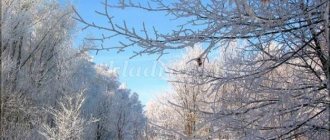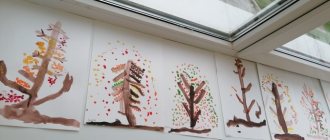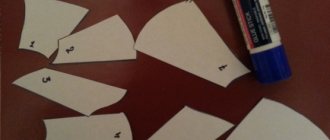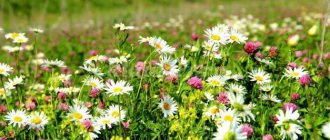My little homeland. Summary of integrated educational activities
Topic: “My small Motherland”
Abstract
integrated educational activities
on the topic: “My small Motherland”
Prepared by: senior group teacher Margieva Dinara Dilyaverovna
TO
overview of direct educational activities
Topic: “My small Motherland”
Goal: to develop feelings of patriotism and love for one’s Motherland.
During the lesson, tasks are implemented in the following educational areas: Educational areas “Cognitive development” and “Socio-communicative development”
- introduce children to the concepts of: family, clan, relatives, large and small Motherland;
— enrich children’s knowledge about their small homeland - the Republic of Crimea; - develop an emotional and value-based attitude towards the natural environment and attractions of the native land. — to cultivate in children a love for the big and small Motherland and a desire to enhance the natural, cultural and historical heritage. Educational area “Speech development”
- strengthen children’s skills to correctly correlate a noun with an adjective: big and small Motherland, native country, native Crimea, favorite village;
dear mother, close relatives; gentle sea, basking country, ripe grapes, bunches of grapes, grapevine, sweet raisins. — teach children to expressively narrate the works of Crimean and Russian children’s poets. Educational area “Artistic and aesthetic development” -
strengthen children’s skills in drawing a bunch of grapes with their fingers
Educational area “Physical development” –
develop fine motor skills, motor activity of children through finger and folk games; develop physical qualities, coordination, flexibility.
Methods and techniques
: - visual: map of Crimea, illustrations of grape varieties, dummies of grape bunches; - verbal: conversation, literary word, story of a legend; — practical: tasting juices, raisins; finger painting; individual work to consolidate the pronunciation of words from an active dictionary, expressive reading of poems using facial expressions and gestures.
Preliminary work:
conversation about Russia, Crimea. Reading proverbs and sayings, poems, legends about the Motherland, about Crimea, looking at photographs of the sights of the native land, excursions around the native village.
Material:
audio recording of the children's song “Our Land” lyrics. Prisheltsa A., composer Kabalevsky D.; poster Crimea, bunches of grapes, illustrations using ICT.
Progress:
The teacher reads a poem:
There are many mothers in the world, Children love them with all their souls, There is only one mother, She is dearer to me than anyone else!
Who is she? I will answer: My dear mother! Question
: What kind of mommy?
- Dear! Let's repeat gently and affectionately: - dear mother_ How do you understand the meaning of the word dear? Children's answers. Educator:
Native means dear, close, beloved, sweetheart.
Question: Who or what else can we call family? Answers
: dad, brother, sister, uncle, home, kindergarten, country, city, region.
Generalization: A place where everything near and dear can be called your homeland in another way. Educator:
Each of us has a big Motherland and a small Motherland. The Big Motherland is our big country. What is it called? (Russia).
Play audio recording “My Motherland”
Educator
. That's right - we are part of Russia, this is our big Motherland. But everyone also has their own small homeland. Diana, Nastya and Karina know poems about their small Motherland, let's listen to them. Poem: Small Motherland is an island of land. Under the window, the currants and cherries blossomed. There is a curly apple tree, and under it there is a bench. My affectionate little Motherland! Motherland is a big, big word! Let there be no miracles in the world, If you say this word with your soul, It is deeper than the seas, higher than the skies! It fits exactly half the world: Mom and Dad, neighbors, friends. Dear city, dear apartment, Grandmother, kindergarten, kitten and me! (Tatiana Bokova)
Educator
.
How did you understand what a small homeland is? Children. I think that the small Motherland is the house in which I live, these are my parents, the village, the city. Educator. Guys, where is your little homeland? Children
. My little homeland is here, in Shkolnoe. Our village is in Crimea. A small country basks in the palms of the gentle sea, The mountains protect its sleep, The wave sings a lullaby... Crimea is a health resort and a miracle garden. Crimea is fruit, it is sweet grapes. Crimea is the sea, it is a paradise. Crimea is a steep southern mountain. Crimea is steppes and protected forests. Crimea is a fairy tale that looks into your eyes. So, guys, I want to tell you one such fairy tale: Let us try to travel to the distant, distant past, when people had not yet appeared on earth. A strong earthquake occurred and the earth's land rose from the sea waters. This is how our Crimea appeared. The wind and birds brought seeds of various plants to the Crimean land. Among them are grapes. But the grapes are wild, with small, black and sour berries. Birds and animals eagerly feasted on wild grapes. But then people appeared. Gradually they learned a lot: to build houses, grow plants. And then they paid attention to the wild grapes. They began to choose larger and sweeter ones. Over time, cultivated grapes were developed from wild grapes. Until now, scientists are developing new varieties of grapes: there are seedless grapes, with round, oval berries and many, many other varieties. Now think and tell me, who is a winegrower? This is a person who grows grapes. A piece of land on which grapes grow is called a “vineyard.” Our Crimean land is very suitable for growing grapes. If you drive along our peninsula, you will see many vineyards. There are many different varieties of grapes. Today we have three varieties: “Muscat”, “Isabella” and “Rkatsiteli”. Now it’s late autumn and we won’t be able to try them. When something is tasted to determine the taste or smell, it is called tasting. But now we will have a tasting of grape juice.
Juice tasting
Berries grown together, side by side, are called a bunch of grapes. An ancient legend tells where grape brushes of different colors came from. You and I have already read legends, and we know that this is a fairy-tale story about something that actually exists.
The Legend of the Grapes
“Grapes appeared on Earth a very, very long time ago. His mother was the Earth, his father was the Sun. At the time of the birth of grapes, their clusters did not take a month or two to ripen, as now, but quickly - from the day before dusk (evening), and those that managed to ripen by dawn borrowed its gentle blush from the morning dawn and turned pink. The grapes, ripened during the day, became golden yellow - they took over the gold of its rays from the sun shining brightly in the sky. The southern night imparted its dark or velvety blue tones to the berries that ripened late in the evening.” Nowadays, grapes ripen for several months: the first ripens in mid-summer, and the last, late grapes are harvested in mid-autumn. But the earth and the sun are still the parents of grapes. Without the sun, neither a grain nor a berry can ripen. The earth provides nutrition to the roots of the grape bush. But the stem and branches of a grape bush are called “vine”. Repeat this word and try to remember. The vine is flexible, long and thin. To prevent it from breaking due to the weight of the grape clusters, winegrowers tie the vine to a post. Birds, insects, and animals love grapes just as much as humans. Bees, wasps, and ants love to eat grapes. Hamsters hide grape berries in their cheeks and carry them into their underground storage room. And sparrows, rooks, and crows peck sweet berries directly from the vine. Let's play the outdoor game "Birds and Grapes."
Dynamic poise “Birds and Grapes”
Children pretend to run (“fly”) as birds. The leader (“watchman”), on the command “The watchman is coming,” begins to catch the “bird” children. At all times, people have valued grapes. In the old days, when wars raged on our peninsula, the victors dug up grapevines and took them home. After all, grapes provide not only delicious berries. Juice and wine are made from grapes. And also a delicious treat. Here it is. (Showing raisins). Do you know what this is? These are raisins - dried grape berries. For raisins, choose seedless grapes. Let's have a raisin tasting.
Raisin tasting
It turns out that grapes can still cure some diseases. And it also cleanses the human body, giving it strength and health. Let's draw a bunch of grapes. But first, let's prepare our fingers for work. These are the ones we will draw with.
Finger gymnastics “Grapes”
The index finger is the most inquisitive. He can press buttons, he can pick holes. And it depends on the owner how to use the craftsman. We'll train our finger and he'll draw grapes. Children clench their right hand into a fist, extend their index finger, press it onto the palm of their left hand and make rotational movements in one direction and the other. Then the same is done with the left hand.
Drawing “Bunches of Grapes”
Play the audio recording “My Motherland Without Words”
Children draw grapes with their fingers on a sheet of paper with a leaf, tendril and twig drawn on it. The teacher draws the children's attention to the fact that you can achieve different sizes of berries by changing the pressure of your finger. You can invite children to choose the color of their grapes. Pay attention to the shape of the thunderstorm: there are more berries on top, the lower, the fewer berries.
Questions:
1. How do cultivated grapes differ from wild grapes? 2. Who are winegrowers? 3. What is the trunk of a grape bush called? 4. What color are grape berries? 5. Retell the legend about the grapes. 6. What is made from grapes? 7. What are raisins called? 8. Who, besides man, loves grapes? By the way! Have you noticed that our Crimea is shaped like a bunch of grapes? Crimea is our Motherland, remember this! Do not spare your soul for her sake, Let the peaceful, kind sun rise over this green island!








